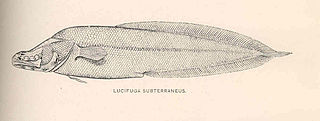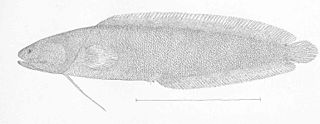Ophidiiformes is an order of ray-finned fish that includes the cusk-eels, pearlfishes, viviparous brotulas, and others. Members of this order have small heads and long slender bodies. They have either smooth scales or no scales, a long dorsal fin and an anal fin that typically runs into the caudal fin. They mostly come from the tropics and subtropics, and live in both freshwater and marine habitats, including abyssal depths. They have adopted a range of feeding methods and lifestyles, including parasitism. The majority are egg-laying, but some are viviparous.

The cusk-eel family, Ophidiidae, is a group of marine bony fishes in the Ophidiiformes order. The scientific name is from the Greek ophis meaning "snake", and refers to their eel-like appearance. True eels diverged from other ray-finned fish during the Jurassic, while cusk-eels are part of the Percomorpha clade, along with tuna, perch, seahorses and others.

The viviparous brotulas form a family, the Bythitidae, of ophidiiform fishes. They are known as viviparous brotulas as they generally bear live young, although there are indications that some species do not. They are generally infrequently seen, somewhat tadpole-like in overall shape and mostly about 5–10 cm (2–4 in) in length, but some species grow far larger and may surpass 60 cm (2 ft).

Lucifuga is a genus of viviparous brotulas. Most of the species are native to caves and sinkholes in Cuba and the Bahamas; L. inopinata from deep water off the Galápagos Islands is the only exception. The four species rated by the IUCN are all considered vulnerable. The largest species in the genus reaches about 15 cm (5.9 in) in length.

Ogilbia is a genus of viviparous brotulas. The generic name honours the Australian naturalist James Douglas Ogilby (1853-1925), for his contribution to the knowledge of the fishes of Australia.

The Mexican blind brotula is a species of viviparous brotula endemic to Mexico, where it is found in sinkholes and caves. It is known as sak kay in Mayan and dama blanca ciega in Spanish. This cavefish grows to a standard length of 9.7 cm (3.8 in). It is the only known member of its genus.

Saccogaster is a genus of viviparous brotulas. They are found in the western Atlantic and Indo-Pacific.
Bellottia is a genus of viviparous brotulas which is found in the subtropical waters of the North Atlantic, the Mediterranean Sea and the Indo-Pacific.

Bidenichthys is a genus of viviparous brotulas.
Majungaichthys is a genus of viviparous brotulas native to the western Indian Ocean. The generic name refers to Majunga in Madagascar where the type was collected.
Mascarenichthys is a genus of viviparous brotulas. They have mostly been collected from the region of Mascarene Plateau in the Indian Ocean and this is referred to in their generic name.
Microbrotula is a genus of viviparous brotulas.
Ogilbichthys is a genus of viviparous brotulas found in the central-western Atlantic Ocean and the Caribbean Sea. The generic name refers to the resemblance of these fish to those in the genus Ogilbia, a name honours the Australian naturalist James Douglas Ogilby (1853-1925), combined with ichthys which means "fish" in Greek.
Paradiancistrus is a genus of viviparous brotulas.

Bidenichthys beeblebroxi is a species of common reef fish of the family Bythitidae. The species is found in the coastal waters off North Island and northern South Island, New Zealand. It is a common, uniformly gray-brown fish, ranging from SL 6.5–9.5 centimetres long in one study, found in holes beneath rocks and boulders in kelp forest and other reef habitats from the surface down to depths of 30 metres (98 ft). The species was described by Chris D. Paulin in 1995. IUCN and the Catalog of Fishes consider it a synonym of Bidenichthys consobrinus.

Dinematichthyini is a tribe of viviparous brotulas, which is conventionally placed within the subfamily Brosmophycinae. They are differentiated from the other tribe within that subfamily, the Brosmophycinae, by having a single pair of ossified genital claspers, having an absence or greatly reduced scales on the head and having the posterior end of the maxillary bone showing a small amount of vertical expansion. A review of the viviparous brotulas carried out in 2016 elevated the tribe to a family, the Dinematichthyidae.

Brosmophycini is a tribe of viviparous brotula, one of two tribes in the subfamily Brosmophycinae. They are distinguished from the other brosmophycin tribe, the Dinematichthyini, by having a male intromittent organ which has no ossified parts, a scale-covered body and well developed gill rakers.

Bythitinae is a subfamily of viviparous brotulas, one of the two subfamilies in the family Bythitidae. This subfamily is characterised by having the dorsal, caudal and anal fins combined. They are mostly found in temperate to tropical seas, from reefs to the benthopelagic zone, but some species from the North Atlantic Ocean occur in into Arctic waters.
Bythitoidei is a suborder of the order Ophidiiformes, the cusk eels. They are distinguished from the other Ophidiform suborder, the Ophidioidei, by being largely viviparous.
Mascarenichthys heemstrai is a ray-finned fish species from the family of Bythitidae in the genus of Mascarenichthys. The scientific name of the species was first published in 2007 by Schwarzhans & Møller, It was named after Phil Heemstra, a notable ichthyologist.









